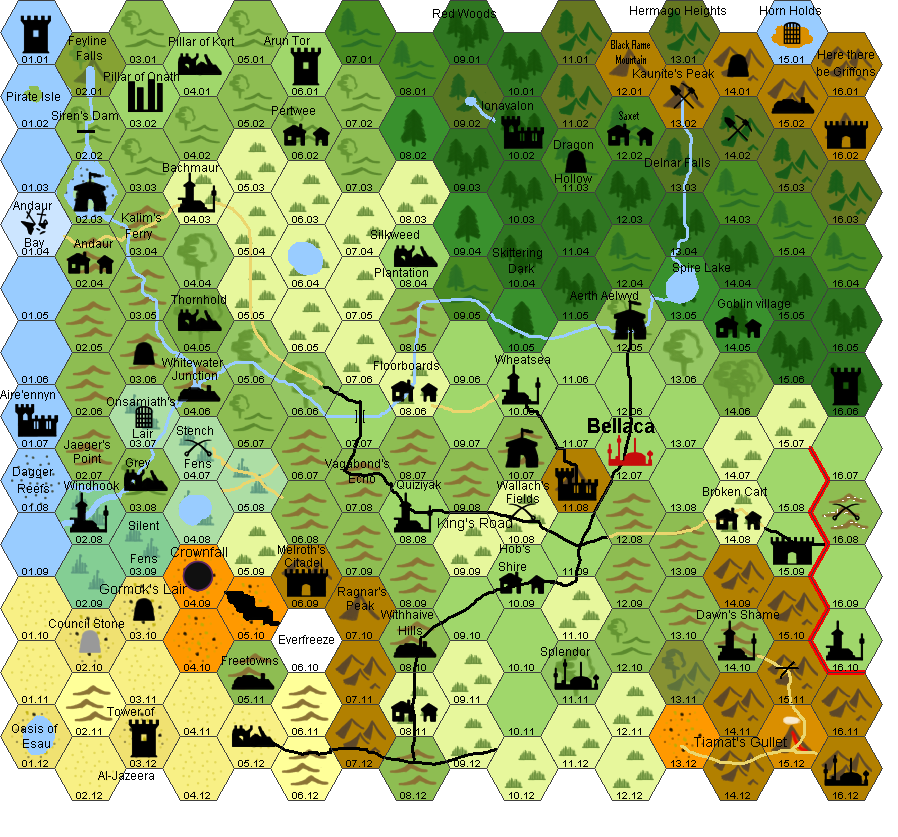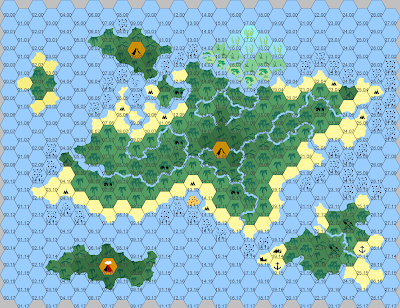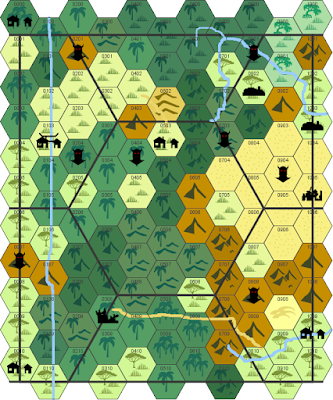
In classic Dungeons & Dragons it was common to have the adventurers delving into a subterranean catacomb, mineshaft, cave, or dungeon. But one element that is equally important is the outside wilderness. Having a vast world to explore is called a "Hexcrawl" (or in more modern times, an "open world" or "sandbox"). The classic hexagon grids used for outdoor regions were a defining feature presented for player-characters to spend their days exploring and traveling from one point to the next.
Today I'm going to show you my method for creating a hexcrawl, but of course like most RPG-related things, there are nearly countless other methods as well.
Step 1 - Create Three Quests (Each With Three Objectives)
The first step, which I want to credit to Dave Chalker's 5x5 Method, is to create three quest lines. Two of these quests will be optional "side quests", with the center quest being the "main" quest. The main quest is where you'll be focusing a lot of your attention, and is often the quest in which you would entitle your module after (such as "The Dead King's Crown" or "Redeemer of the Dead King").Each quest is broken up into three objectives; arranged in a 3x3 grid where the rows represent the quests, and the columns represent the quests' objectives (more on that later).
Quest Types
When creating quest objectives, I like to choose between a generic list that I then morph and change to suit my needs.Offensive Objectives
- Placement -- Secretly place an item (or person) in a place of importance
- Espionage -- Spy on an area (or person) and report the findings
- Destruction -- Destroy an item, person or place
- Capture -- Capture/abduct an item (or person) of importance
- Sabotage -- Break/trap/change a certain item, person or location
- Infiltration -- Travel to and/or sneak in an area far away or controlled by enemies
- Investigate -- Uncover a hidden item, spy or secret plot
- Obfuscate -- Hide (or disguise) an item (or person) from being found or spied upon
- Defense -- Protect an item, person or location of importance
- Liberation -- Set free/liberate an item, place or person of importance
- Restoration -- Repair, restore (or heal) a certain item, location or person
- Escape -- Escape from pursuing enemies or an area controlled by enemies
Quest 1 (Optional): Pirate's Booty -- The constable of the town is willing to hire a band of adventurers to find the source of black market goods that have been flooding the hamlet as of late. The investigation will lead the party to a small pirate's cove tucked away from the main trade routes. There they will find the pirate king Arden 'Lost Soul' Chrom, who is leading the illegal business.
Quest 2 (Main): Dead King's Crown -- The sacred crown of the late king Tipelon the Illustrious has been missing from his tomb. Recently, it has turned up for sale in the shady back-alley markets. The local bishop of the church wants a party of adventurers to brave the dangerous catacomb in an effort to return the crown to the crypt, where it belongs.
Quest 3 (Optional): Invading Marauders -- Late last night a scout came running into town with important news concerning an army marching towards the border. The lieutenant of the kingdom's garrison wants a band of adventurers to verify the information before he sends help for additional troops (in an effort to defend the borders). The party is to find the army, spy on them and perhaps even infiltrate their ranks for additional intel.
Now that we have three rough sketches, we want to organize them each into three objectives. For the first quest ("Pirate's Booty"), we can say the objectives are as follows:
Pirate's Booty
Objective 1 -- Investigate: Ask around the local thief's guild and black market for illegal wares. Follow the money trail until the pirate's cove is discussed and placed on the map.
Objective 2 -- Infiltration: Travel to the cove, then sneak into the pirate's camp to either sabotage the operation or confront (and defeat) the pirate king.
Objective 3 -- Capture/Liberation: Arrest the surviving pirates, and confiscate their stolen goods. Devise a plan to bring all of the captors, booty and ships back to town for processing. The stolen goods are given back to the people, and the pirates are thrown in prison.
Let's do the same for the two other quests.
Dead King's Crown
Objective 1 -- Defense: Travel to the catacomb with the ancient crown. Little do the adventurers know, their movements are being watched and will be ambushed by a thief organization along the way (in an attempt to steal the priceless item).
Objective 2 -- Infiltration: The adventurers must navigate the dangers within the catacomb, making their way to the burial chamber.
Objective 3 -- Escape: Upon placing the crown back on the head of the king's corpse, an ancient trap set to protect such theft is sprung (that didn't trigger when the looter's originally took the crown). The trap is designed to forever entomb the party deep within the catacomb (unless they can out-run the collapsing chambers).
Invading Marauders
Objective 1 -- Espionage: The party must seek out and find the marching army's camp. The party is tasked with reporting on certain details; such as the number of troops, siege weaponry, etc.
Objective 2 -- Infiltration/Investigation: The party was also tasked with finding out who is leading the army, and why. This requires infiltrating the ranks of the army at night and masquerading as one of the soldiers. Information is gathered about Hjora, the commander of the army.
Objective 3 -- Escape/Sabotage: The party must escape from the camp with the information, and/or sabotage the army's efforts to advance (in an attempt to slow them down).

Dynamic vs Static
Next we ask ourselves if we want some of the objectives to be dynamic or static. A dynamic objective will change depending on whether the task is "completed", "failed" or simply "ignored". A static quest, on the other hand, simply remains frozen in time until the party walks up to it and attempts to complete it.Most objectives are usually static, and do not change over the course of time. However, adding a few dynamics can add variety to the adventure, and offer a sense of a living, reactionary world.
If the party successfully completes an objective, one outcome triggers. If they attempt but fail, another outcome will trigger. Lastly, if the objective is ignored (and the party pursues the second or third tier of another quest), a tertiary outcome could trigger. Outcomes can be thought of as branches in a flow chart. They can lead to all-new objectives within that quest, or branch to other objectives of other quests (see below).
For our example, we will say that if the party attempts--but fails--to follow the "pirates booty" black market money (from quest 1), then the pirates grow suspicious of the party's intentions, and go underground. The party will lose the trail. The only way for them to advance further in this quest is to later succeed at the first objective of the "dead king's crown" quest (countering the theif's ambush). If successful, the party will gain information about the pirate's cove, putting it on the map.
We can also say that if the "invading marauders" are ignored, not only will the army march across the borders, they'll begin destroying outlier settlements and farms. This creates a sense of urgency for the party, and a consequence for ignoring an obvious threat to the safety of the countryside.
Lastly, we'll say that if the party successfully completes the second objective of "pirate's booty" (infiltrates the pirate's camp), they'll learn that the pirates were actually hired by the marauding army to steal the crown of the king, in an attempt to embarrass the kingdom and ruin the morale of the settlement prior to invasion.
Cross-Connecting Quests
By tying the quests together like this, the world feels more interconnected and living. Not all quests need to be woven like this, but sometimes it can add a level of depth otherwise missing. When connecting quests in this way; you can make the connections either optional or mandatory. Mandatory connections will demand that the party pursue (and complete) one of the secondary quests (at least partially) in order to advance the main quest line. The idea is to "nest" quest objectives.Strongholds & Maps

Next we need to draw out our map of the countryside. I usually like to have about five day's travel in any direction. I feel like this offers a big enough play area for the party to explore, but not feel like its super massive.
We want to place the landmarks the character's will be exploring in such a way that most corners of the map will get covered. Also consider objectives that are linked or related, and their spatial distance from each other. Try to think of the logical flow the party will travel as they pinball from one objective to another, or even from one quest to the next.
I also like to place a lot of detail on two main strongholds: one "good" settlement (usually a town, village or kingdom). This acts as a safe zone for the party to begin at, and return when they are injured or in need on fresh supplies. The other is a "bad" settlement. This is usually the principle dungeon. In our example, the dead king's catacombs would be our main dungeon.
The other quests, objectives, and landmarks can be discussed, but in far-less detail.
Micro Quests, Rumors & Ecology
As a final garnish, I like to add micro quests (in addition to the side quests already discussed). These help add a sense that the world is full of NPCs with real needs and struggles; separate from the main storyline. Micro quests are small objectives made up of one or two sentences. For example:- A merchant's wagon is stuck in the mud and needs help getting his wares to town.
- A band of hunters got lost in the forest and need help navigating back to their camp.
- A coven of seers wish to complete a pilgrimage to the top of a mountain, but cannot find their sacred cave; and are willing to bless anyone who assists them.
- A vendor in town suspects a boy has been stealing from his tent shop; and is willing to pay a gold coin to anyone who can find the cut purse.
Ecology: A 1d10 list of random landmarks, artifacts and natural phenomena. Again, this helps add a splash of color to the things the players may discover in their travels. These landmarks should help highlight past events, the regional climate, and cultural artifacts. For example, a statue of the king Tipelon could be at a crossroad, or a treasure map leading to the pirate's buried treasure hidden in the thief's camp, or relics of a past war between the kingdom's army and the marauders are half-buried on the borders of the countryside.

A nice methodical approach. I like it.
ReplyDeleteI only wish I had a way to easily create lovely hex maps like these.
ReplyDeletehttp://www.hexographer.com/ is what you seek JB. Play around with the free demo versions.
DeleteThis comment has been removed by the author.
Delete